INTRODUCTION
In general, the construction and components of a geothermal power plant are similar to those of other power plants such as coal and gas plants except that geothermal power plants do not have boilers. Other specific feature in geothermal power plant is it uses geothermal fluid that has special characteristic that differs from surface fluid. Various components build the function of the geothermal power plant. Related to these typical conditions, there is no available single indicator that is able to present the reliability degree of the geothermal power plant. Therefore, it is important to build composite reliability indicator to present the reliability degree of the geothermal power plant. The composite indicator may be built base on several single indicators, namely: net electricity production, auxiliary load, steam supply, internal problem of scaling, internal problem of corrosion, other internal problems, risk of internal scaling problem, risk of internal corrosion problem, as well as external problem and problem risk. Those several single indicators can be selected so that the composite indicator can represent some typical aspects of the geothermal power plant, which are in line with the objective and context of reliability. A good reliability of the system can be achieved by a proper management of maintenance of the existing system.
RELEVANCE FOR AND APPLICABILITY TO INDONESIA
Based on field observation in some fields, maintenance activities of most geothermal power plants in Indonesia have not become the first priority by the operators. For examples, we can find that some important measurement instruments are not installed in the facilities. Other situation is that the instruments have been already installed but most of them are broken, so that they are not in the functional purpose. Some instruments are not calibrated in a proper procedure results in doubt measurement results. From this situation, it is difficult to make analysis such as performance of power plant, simulation of the process in specific equipment, etc. since no or limited available measured data. It is common to assume some parameters for analysis purpose, which is of course decreasing the level of confidence.
In terms of maintenance management implementation, the situation are quite different from one operator to other ones. There are some operators that have already implemented reliability centred maintenance while others still use conventional way. We still find that the critical equipment are not maintained in a proper way, so that they are repaired after they broken since the first installation. Considering this situation, the maintenance issue in Indonesia should be considered as the critical problem. The operators should be aware for the reliability and availability of geothermal power plant equipment. This issue was also addressed to the participants.
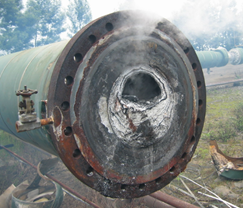
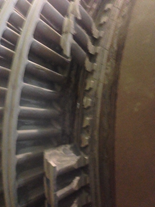
Figure 50 Typical problems found in the fields due to the impurity of geothermal fluid; silica scaling in pipes (left) and erosion on turbine blades (right)
GEOCAP ACTIVITY IN THIS TOPIC
This course was held in three different places and times according to the targeted participants, i.e. inspectors, operators or engineers. But in general, the courses contain similar modules that cover basic knowledge of heat transfer, thermodynamics and fluid mechanics, geothermal power plant systems and technology including various types of geothermal power cycles, design and standard of main component of geothermal power plants, maintenance and reliability for geothermal power plants, inspection techniques, sampling and reporting, and geothermal power plant safety.
Most of the participants come from universities, some from governmental staff and few from companies. In order to give better picture of what and how geothermal power plant works including the problems that are common in the development of geothermal resources, the participants had a field trip to one of geothermal fields in Central Java, called as Dieng field. The guest instructors from company and government were invited to give update on the current situation on the geothermal development in Indonesia. At the end of the course, the comprehensive test was conducted to evaluate the understanding of different aspects of knowledge given during the lectures.
The main modules are summarized as follows:
1-Basic knowledge of thermodynamics, fluid mechanics and heat transfer
This module aims to provide the basic concept for designing power plants including their components in terms of important parameters that involve in flow process. The transportation of geothermal fluid from sub-surface (reservoir) up to the turbine involves those three basic sciences. This concept mostly consists of set of governing equations for calculating thermodynamics properties, heat transfer and fluid flow. The analysis allows us to obtain the optimum design of power plant and its components.
Diagrams of geothermal power plant types (Adapted from Dickson and Fanelli, 2004) can be seen in Figure 51, Figure 52, and Figure 53
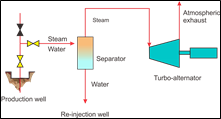
Figure 51 atmospheric (back-pressure) type
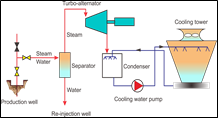
Figure 52 condensing type
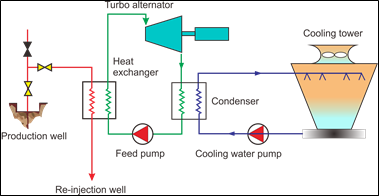
Figure 53 binary type
2-Geothermal power plant systems and technology
The choice of type of geothermal power plant depends on the nature of the geothermal resource. The enthalpy (temperature) of resource is one of parameters that is considered for selecting the power plant type. This module covers the types of geothermal power plant, especially in volcanic setting of geothermal systems. The conventional type requires the fluid temperature at least 1500C and can utilize atmospheric (back-pressure) or condensing types for turbine outlet. Back-pressure types have simple construction and cheaper. The dry steam directly flows from the well or from the flashing process in the separator for wet well is transferred to the turbine and discharged to the atmosphere. The electricity generation from the geothermal fluid for moderate to low enthalpies or from the hot water from the separator for water, dominated geothermal system can use binary fluid technology. The binary power plant uses secondary working fluid, normally organic fluid such as n-pentane that has low boiling point and high steam pressure at low temperature compared with steam.
3-Design and standard of geothermal power plant
The importance of this module is to provide the participants in understanding that the geothermal power plants consists of main equipment and many auxiliary components. It involves mechanical equipment, electrical devices and instrumentation. The standards that are commonly used in the construction of geothermal power plants include ANSI/API, ISO, ASME, ASTM, AWS, NEMA. All designed equipment must follow the required standard.
4- Maintenance and reliability for geothermal power plants
The reliability of the geothermal power plant can be expressed in terms of continuity and stability of steam supply, which is then used to obtain the continuity and stability of electricity production. Correlation between change of steam demand and change of electricity production can provide early indication as a signal of the reliability level of each geothermal power plant. It shows early signal, which is categorized in three problem cases. Case number 1 is if there is an increase in steam demand, which is higher than an increase in electricity production. Case number 2 is if there is a case of higher decrease level on electricity production than decrease level of steam demand. Further, case number 3 is if there is a decrease in electricity production while steam demand increases. Knowing one of these cases will provide us to make appropriate actions in the maintenance activity.
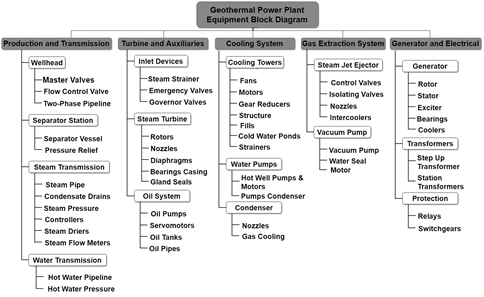
Figure 54 Diagram of basic components of geothermal power plant. (Adapted from Feili et. al., 2013).
In the maintenance activity, it is important to conduct a mapping on various problem risks, problems in the components of the geothermal power plant, their causes and impacts. The geothermal power plant components can be categorized as production well and separator, turbine, condenser and cooling system, gas removal system, piping, pump and valve, electric, instrumentation and control. While the causes of reliability problems can be grouped as scaling, corrosion, erosion, and others (sticking, leakage, debris, fatigue, wash damage, component failures, deformation, burst, lubrication, operational error, calibration, etc.). Reliability Centered Maintenance (RCM) is one of the techniques in the management of maintenance that is widely used in many industrial applications.
5- Inspection techniques in geothermal power plant
In this module, the participants are provided with several knowledge of general inspection and related topics. Inspection activities cannot be separated with the maintenance program. Inspection aims to evaluate one equipment or part of the equipment where possible failure may happen. Failure analysis is one of the key components in the maintenance activities. In order to perform good and proper inspection, the supporting knowledge play an important role such as material technology (types, structure and behaviour, corrosion, failure), instrumentation and testing (non-destructive testing, ultrasonic testing, magnetic testing, radiographic testing, infrared thermography, acoustic emission testing) and safety (hot surface, chemicals, protection equipment, roles). The inspection standard consists of several activities, namely risk assessment for all parts in the installation, inspection protocol, review document after each inspection and failure.
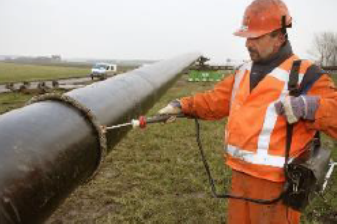
Figure 55 Sample of inspection activity
Materials
CONTACTS
- Khasani (Universitas Gadjah Mada)
- Nasruddin (Universitas Indonesia)
- Jooned Hendrarsakti (Bandung Institute of Technology)

